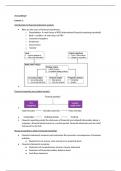Summary
Accounting II summary
- Course
- Institution
This is a summary of the Accounting II course in the 2nd year of the Economics and Business Economics study. The summary is about all the financial and management accounting material you need to know before the exam.
[Show more]



